In early spring, it is difficult not to notice the golden cloud of numerous forsythia flowers. Flowering begins as soon as the snow melts. After flowering ends, the shrub does not lose its decorative appearance; graceful leaves appear, striking in the difference in shades and shapes.
|
The homeland of the culture is East Asia (China, Japan, Korea), this determines the peculiarities of choosing a suitable variety for different regions of Russia. Photos and descriptions of varieties will help you make the right choice. |
| Content:
|
Description of the bush
- Plant height ranges from 1 to 4 m. The bark is gray-brown. Elongated leaves are located opposite on the branches.
- The leaf length varies from 2 to 15 cm, with teeth along the edges.
- Forsythia buds are collected in inflorescences of 3-5 pieces. The yellow tone of the buds, depending on the variety, varies from pale to bright orange.
- Flowering lasts up to 25 days. The flower shape is bell-shaped.
Growing conditions
When choosing a place to plant forsythia seedlings, you should expect that over time it will grow significantly. One of the important criteria when choosing a suitable location is the absence of drafts. The culture is photophilous, but tolerates slight shading.
Forsythia thrives in soil of medium density and low acidity. The main requirement is water permeability. Acidic soils must be limed.
Planting forsythia in the ground
The best time to plant forsythia is autumn. The bush should have time to take root before the first frost. And in areas with a more severe climate, the planting time can be postponed to an earlier date.
|
A seedling planted in spring has enough time to take root, but flowering will be more sparse. |
The planting technology in different regions of Russia is the same:
- dig planting holes 0.7 x 0.7 m in advance;
- pour layers of 20 cm of drainage and 10 cm of sand;
- add humus and ash (or slaked lime) to the planting soil;
- place the root collar at soil level, cover the roots with soil, tamp down and water at the rate of 10–15 liters per plant;
- Sprinkle the tree trunk circle with mulch from humus or fallen leaves. This procedure will help retain moisture in the soil and protect the roots from hypothermia.
It is not recommended to use peat as mulch - it acidifies the soil, which is not suitable for forsythia.
A distance of 1.5-2 m should be maintained between plants. This will simplify crop care and watering in the future. In hedges, the distance between plants is about 50 cm.
Forsythia care
Forsythia requires several simple care measures for successful growth and flowering:
- watering;
- loosening the soil, weeding;
- feeding;
- preparation for winter
Watering and loosening
If there is sufficient rainfall during the season, then watering the forsythia is not required. The plant tolerates drought better than waterlogged soil. But if there is a lack of precipitation, in dry summers, watering is necessary once a month, 10-12 liters per bush.
|
After each moistening, the soil near the tree trunk should be loosened. |
Water the bushes at the root, leaving the leaves dry.
Feeding forsythia
An important component of proper care for forsythia is fertilizing. They begin to feed forsythia from the third year after planting, at the rate of 55-65 g of complete mineral fertilizer per 1 square meter. m. The optimal amount of fertilizing is 2 times a year, after flowering and in the fall.
The quality of feeding directly affects the duration and abundance of flowering. Fertilizers stimulate the formation of buds on the bush for the next season. Autumn feeding helps the plant prepare for winter.
Preparing the plant for winter
In winter, flower buds are most often affected. To preserve them and enjoy abundant flowering in the spring, for the winter the shoots are bent to the ground and covered with spruce branches. Subsequently, snow is raked up to the bush, building a snowdrift over it. For large plants, a shelter made of a wooden frame is equipped, covering it with agrofibre or burlap.
This method is suitable for regions with harsh climates; it allows the bush to breathe and not freeze. With the arrival of spring, the structure is dismantled so that the shoots are not blocked.
|
Frost-resistant varieties in the southern regions and middle zone can winter without shelter; it is enough just to cover the tree trunk with fallen leaves. |
Failure to comply with one or more care conditions can lead to a lack of flowering of the crop.
Trimming
Another factor influencing the flowering and decorative appearance of a shrub is the pruning procedure. Starting from the 4th year after planting, sanitary and formative pruning can be carried out.
Sanitary pruning of forsythia is best done in the spring, and formative pruning at the end of the season or after flowering.
Young bushes are subjected only to sanitary pruning, cutting out frozen, broken and diseased shoots.
To rejuvenate adult bushes, it is necessary to shorten the shoots by one third of the length. This will provoke intensive growth of young shoots. After cutting, forsythia quickly recovers.
With the help of a haircut, you can give the bushes any shape, for example, to form a plant in the form of a tree.
Forsythia propagation
The most productive way to propagate forsythia is vegetatively: by cuttings or layering.
Forsythia can be propagated by cuttings in summer or autumn. In summer, green cuttings are used for this:
- cut cuttings 15 cm long at the beginning of summer,
- the lower leaves are removed from the cuttings,
- the cuttings are kept in Kornevin’s solution,
- planted in greenhouses, constantly moistening,
- after rooting, transplant into prepared soil.
To propagate plants in the fall, only lignified shoots 15–20 cm long are used. They are deepened into the ground 10 cm so that 2 buds remain above the ground. To ensure the desired temperature, cover with fallen leaves.
Rooting rate of cuttings is almost 100%
|
Next year, most cuttings will definitely give roots. The seedlings can be transplanted to a permanent location in the fall. |
Plants grown from cuttings are ready to flower in their third year.
Propagation by layering is another way to easily propagate your favorite shrub.
- in summer or autumn, the lower young shoots are bent to the ground, secured with pins and sprinkled with fertile soil.
- You must first make cuts on the bark - the roots will appear faster.
In the spring of the next season, you can separate the cuttings from the parent bush and transplant them to the chosen location.
The flexible branches of weeping forms of forsythia take root independently at points of contact with the ground.
Forsythia can also be propagated by seeds, but this method is used in rare cases: it gives a low percentage of germination (40%).
Diseases, pests
The plant is resistant to pests and is little susceptible to disease.
In rare cases, the bush may be affected by moniliosis, wilt, or bacteriosis. Wilting can be combated by treating shrubs with foundationazol (2–5%).
Moniliosis is manifested by the appearance of brown spots on the leaf blades. Experts recommend cutting out the affected parts of the crop to healthy tissue. When a bush is infected with nematodes, the soil is disinfected with Carbation.
Plants infected with bacteriosis will have to be destroyed.
Description of forsythia varieties
All types of forsythia cultivated in Russia can be divided into 2 categories: frost-resistant and non-frost-resistant. Frost-resistant varieties and forms are suitable for the Central Russian region, the Urals and Siberia, while non-frost-resistant ones can be planted only in regions with a warm climate.
Frost-resistant varieties
To grow the crop in the gardens of central Russia, the Urals and Siberia, varieties and forms are used that are bred on the basis of the types of forsythia ovoid (oval-leaved), drooping (drooping), intermediate. A little further south you can find varieties of dark green and European forsythia, but they require shelter for the winter.
Unfortunately, even winter-hardy varieties of the crop do not survive in the north of the country. In the regions north of Moscow, even if the crop grows, it blooms very sparingly or does not bloom at all.
In the middle Urals it is better to grow medium forsythia varieties. This is a hybrid obtained by crossing pendulous forsythia and green forsythia. Characterized by bright yellow flowers, drought resistance and winter hardiness.
Forsythia ovata Nakai
The most frost-resistant species. The height of an adult plant is 1.5-2 m. The shoots are spreading, the growth rate is average, and it is drought-resistant. It overwinters without shelter; in the most severe winters, only the tips of annual shoots freeze. The flowers are small, 2 cm in diameter. Flowering is early, but short-lived, 10-17 days. Autumn leaf color is reddish-orange.
Popular varieties of forsythia oval-leaved (ovoid) among gardeners:
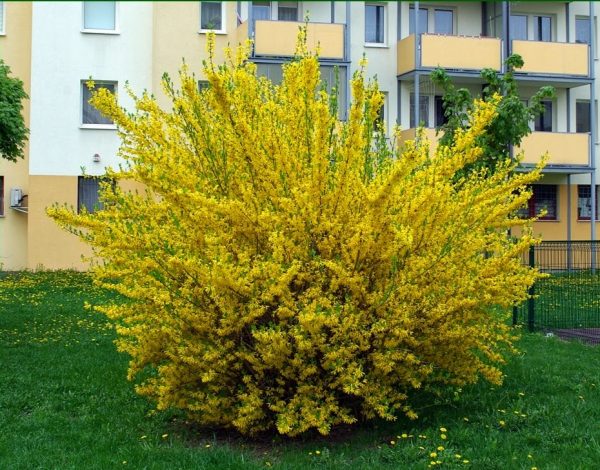
Goldzauber
Goldzauber - blooms for 3 weeks, the flowers are large, frost resistance is higher than other varieties.
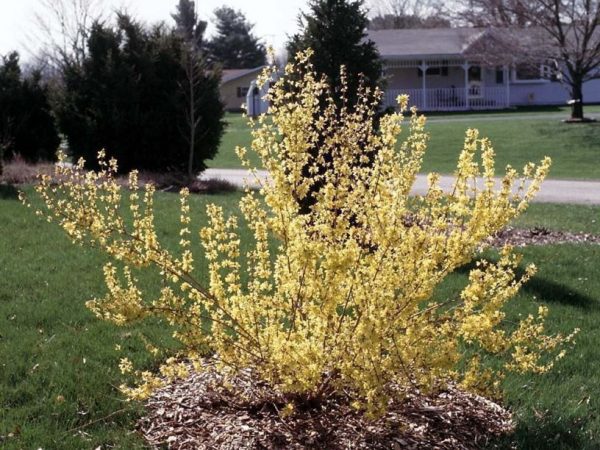
Drezdner forfruling
Drezdner forfruling - a bush with a dense crown 2 m high, large flowers of a light shade.Blooms early and abundantly. Grows well in the Urals.

Ottawa
Ottawa - compact, with amber-colored flowers.
Hanging/drooping forsythia (Forsythia suspensa)
Shrub up to 3 m high, with thin drooping branches. It is actively used in ornamental gardening in the Crimea, the Caucasus and Central Asia. It is considered a winter-hardy and hardy species, but in the conditions of the Central Russian zone, shelter for the winter is necessary.
The best varieties and forms of drooping forsythia:

Sieboldii (Sieboldii)
Sieboldii (Sieboldii) is the most winter-hardy form. It is characterized by short stature.
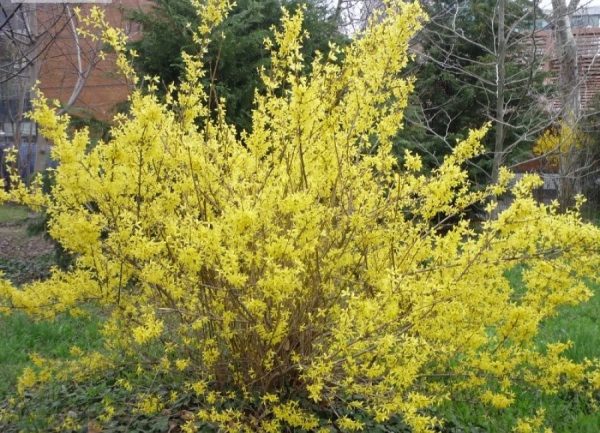
Newmans
Nymans is a tall shrub with brown shoots and light yellow flowers.
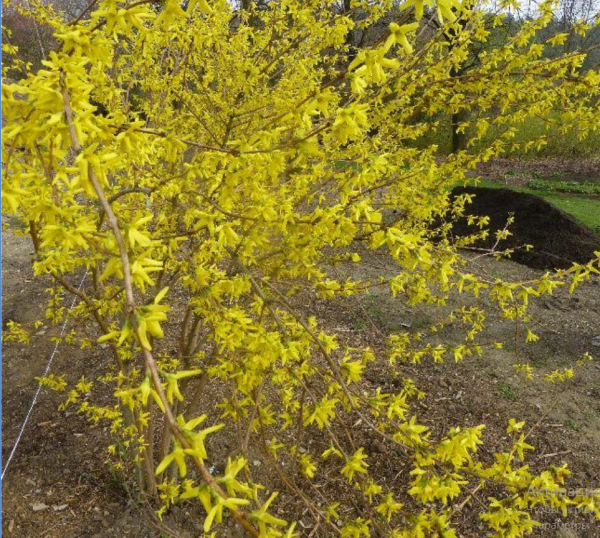
Taff Arnold
Taff Arnold (Taff’s Arnold) – height up to 2.5 m, cream flowers, leaves decorated with purple spots.
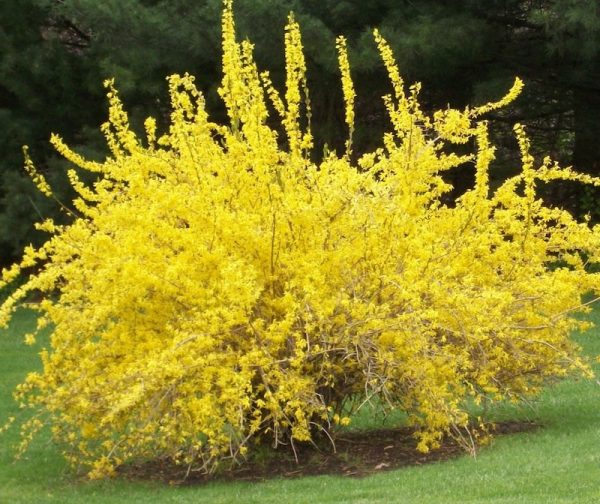
Hewitt's Gold
Hewitt's Gold - attracts gardeners with bright golden flowers.
Forsythia x intermedia
The most versatile species is forsythia middle (or intermediate). This hybrid is the result of crossing green forsythia and drooping forsythia. Bred for areas with temperate climates, therefore it has properties such as drought and frost resistance. In the conditions of central Russia, it requires shelter for the winter.
The intermediate forsythia shrub is distinguished by its height up to 3 m, fast growth, and bright yellow flowers. The bush begins to bloom at the age of 3 in April-May.
Popular forms and varieties:
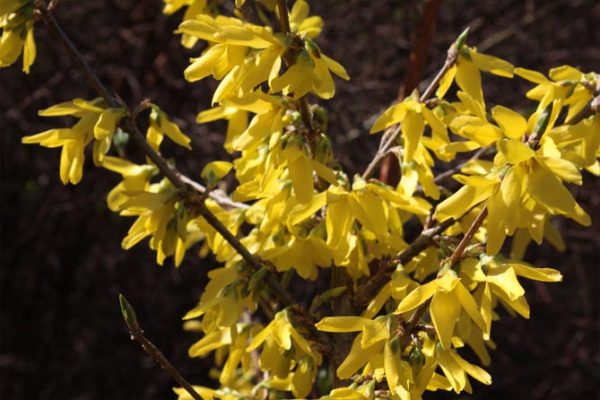
Densiflora
Densiflora is a shrub 1.5 - 2 meters high with curled petals of a soft yellow hue.

Primrose (Primulina)
Primrose (Primulina) - the petals are wavy, the flowers are located at the base of the branches.
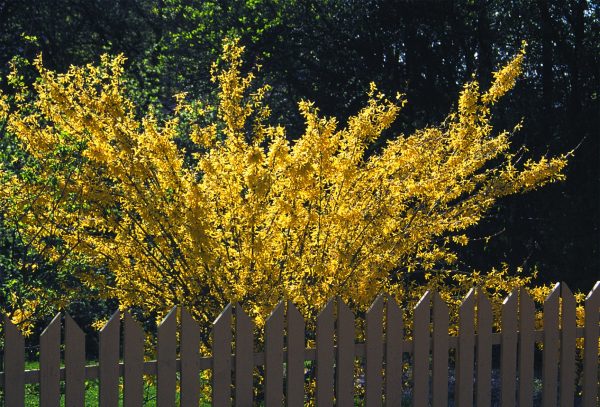
Wonderful (Spectabilis)
Wonderful (Spectabilis) - height up to 2 m, with spreading, hanging shoots and large flowers. The variety deservedly enjoys the love of gardeners.
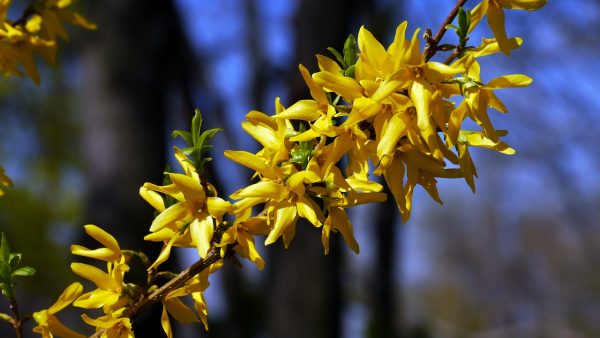
Spring Glory
Spring Glory - the height of an adult shrub is 1.5-3 m. Large flowers grow in clusters. In autumn, the leaves are bright yellow and pale purple.
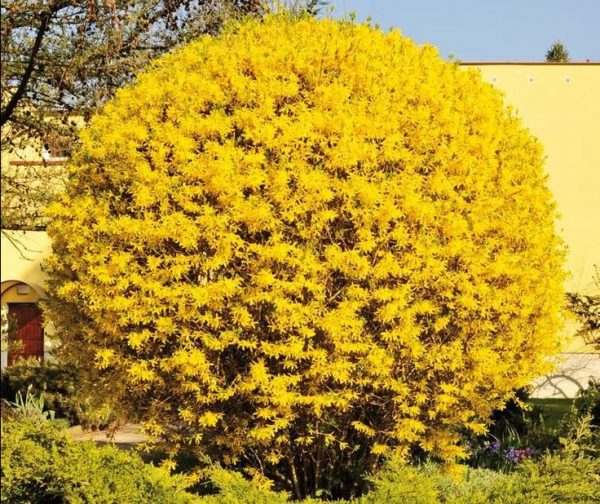
Lynwood Gold
Lynwood Gold is a fast-growing shrub characterized by abundant flowering and a variegated crown.
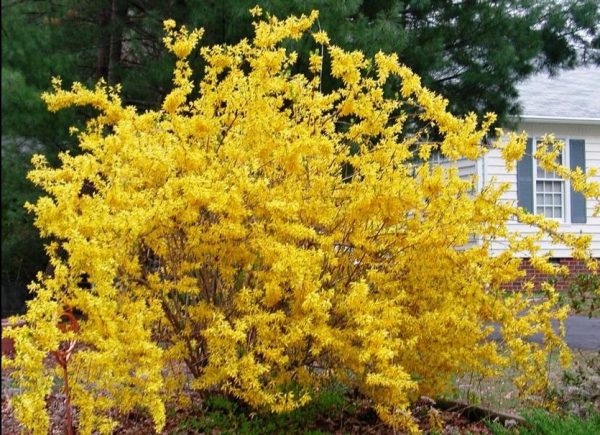
Week End
Week End - up to 2 m tall with straight branches and large flowers. Characterized by early flowering.
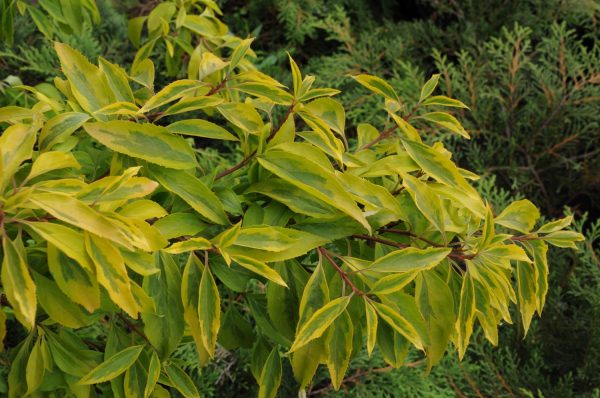
Golden Time
Golden Time is an undemanding bush with voluminous flowers, tolerates even severe frosts, variegated.
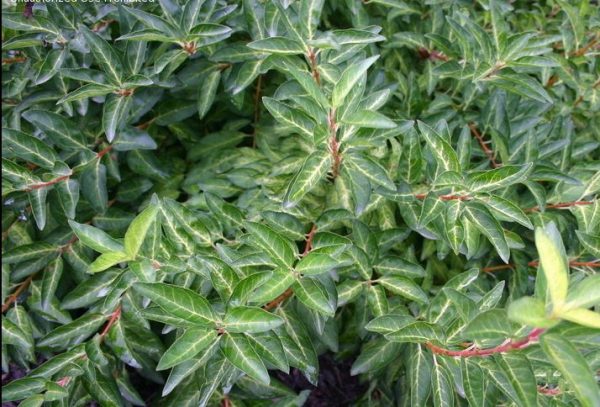
Fiesta
Fiesta is a compact fast-growing variety 1.5 m high. The leaves are decorated with decorative spots.
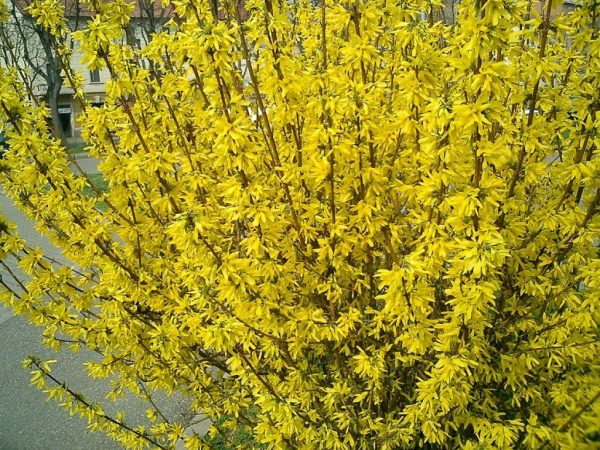
Parkdecor
Parkdecor – height up to 2 m, dark yellow flowers up to 5.5 cm in diameter. Flowering early and abundant.
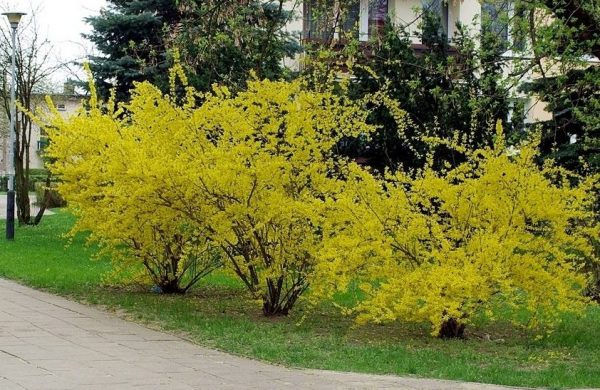
Beatrix Farrand
Beatrix Farrand - height up to 4 m. There is a dark stripe on the bright yellow petals at the base of the corolla.
Varieties with a dense crown are successfully used to create dense green hedges. During flowering, forsythia looks impressive against the background of conifers.
Varieties for the southern regions
Types of forsythia that are suitable for the warm climate of the southern regions and do not tolerate low temperatures:
- Greenest
- European
- Giralda.
Dark green/greenest forsythia (Forsythia viridissima)
Tall shrub with straight stems. The leaves are dark green, turning purple in autumn. Bright yellow flowers bloom in April. In temperate latitudes, without shelter, it freezes in winter.
The basis of some varieties was a subspecies of the greenest forsythia - Korean forsythia. This subspecies is characterized by beautiful leaves with toothed edges, a network of creamy veins and large flowers.
Korean forsythia variety:
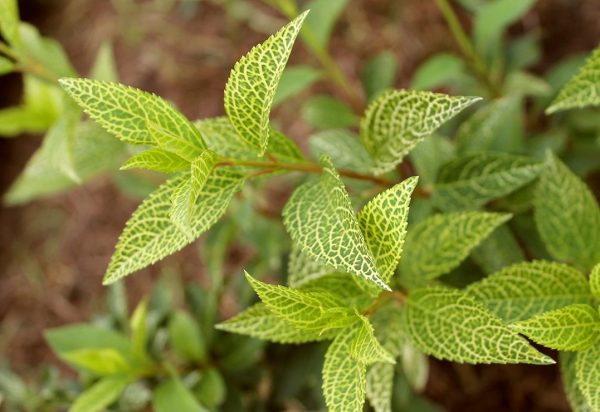
Kumson
Kumson is a variety with cream-colored veins on the leaves.
European forsythia (Forsythia europaea)
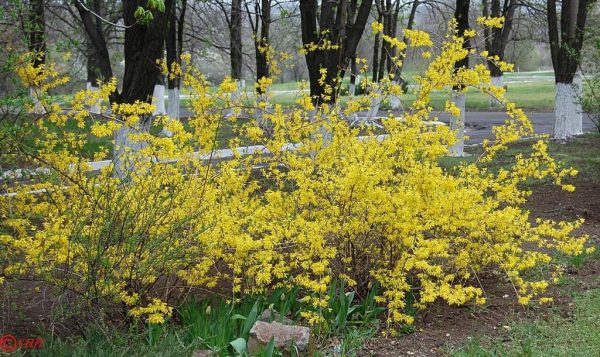
European forsythia (Forsythia europaea)
Shrubs of this species grow up to 2 m. The leaves are large, the flowers are single, and they bloom early. It is a heat-loving crop and is cultivated more often in the southern regions. In the conditions of the Central Russian strip, flower buds freeze above the snow level.
Forsythia giraldiana
Without shelter, it can only be grown in the southern regions of Russia. Leaves up to 10 cm long. Blooms profusely from age 5. The flowers are light yellow, large, with twisted petals.
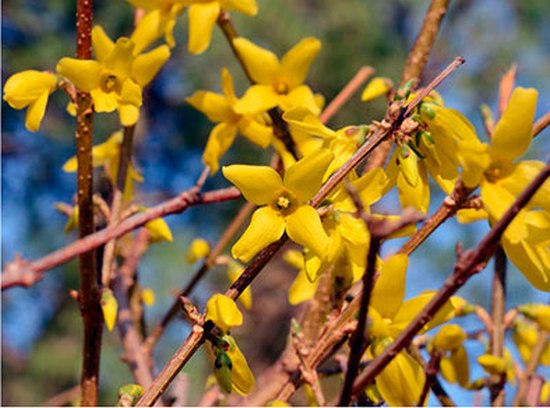
Purple stem (Artocaulis)
Purple stem (Artocaulis) - characterized by red shoots. At the moment of opening, the leaves are painted in the same color.
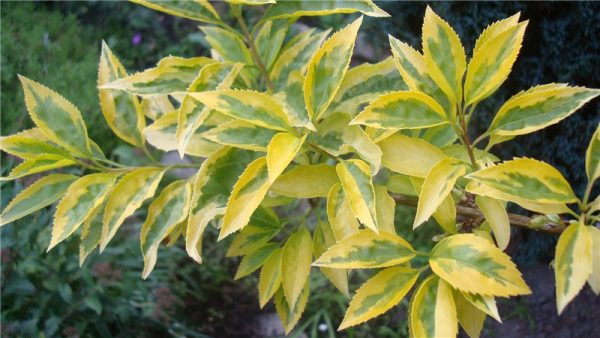
Variegata
Variegated (Variegata) - variegated leaves.
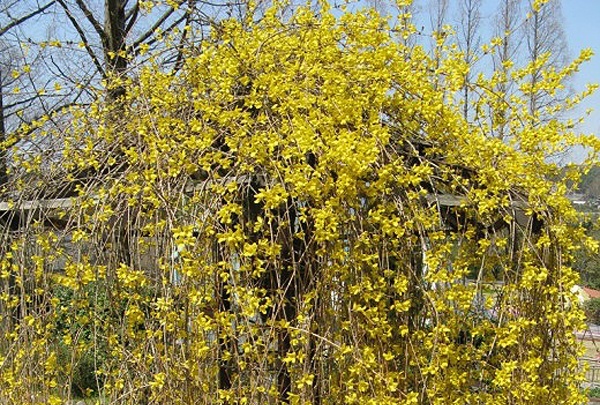
Forsythia hanging Fortune
Forsythia hanging Fortune (Forsythia) is a shrub up to 3 m in height, blooms at the age of 5 - 6 years, flowering is not annual and does not last long. Winter hardiness is low.
White forsythia variety
White or snow forsythia (Forsythia abeliophyllum) enjoys well-deserved love among gardeners. It differs from all other varieties in its large white flowers with a yellowish throat and a light pink center. The height of the bush is 1.5-2 m.
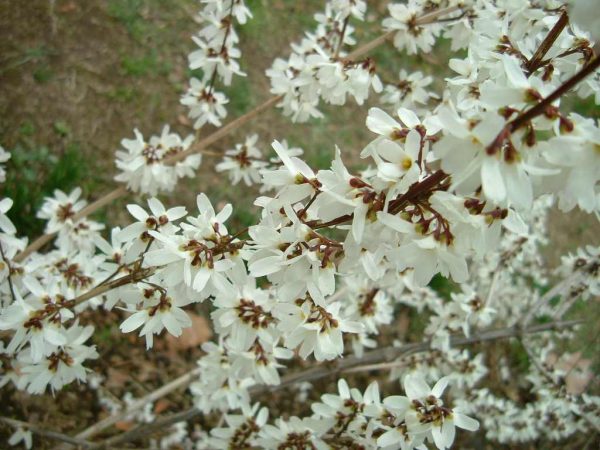
White forsythia (Forsythia abeliophyllum)
In autumn, the leaves turn from dark green to purple. This variety is often shaped like a tree.
Dwarf varieties
Low-growing garden forms of forsythia deserve attention.To maintain their decorative appearance, dwarf varieties require constant pruning, otherwise the leaves become smaller and flowering is not abundant.
Dwarf varieties are planted on lawns as an accent to complex compositions
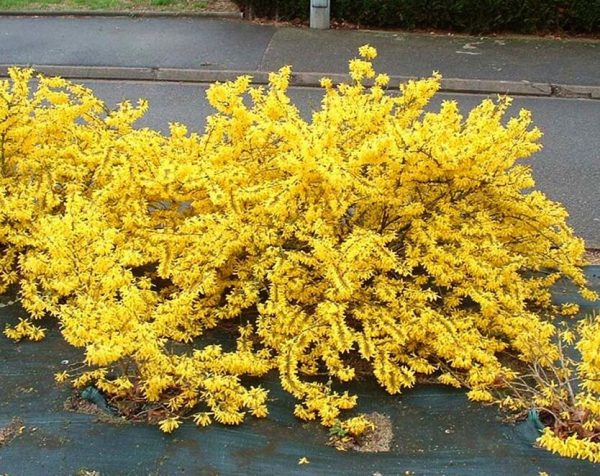
Cortasol
Cortasol is a dwarf variety with creeping shoots no more than 50 cm high.
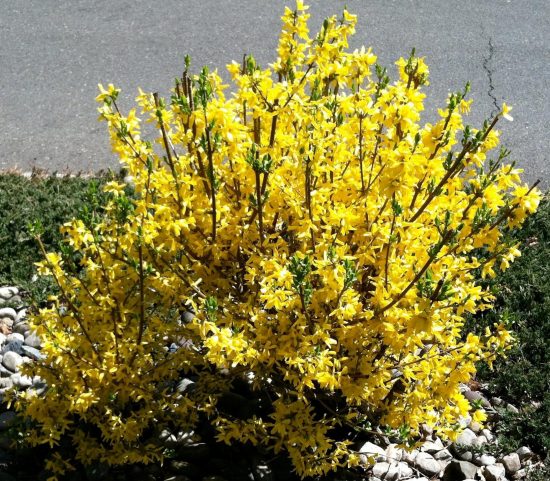
Minigold
Minigold is a low-growing variety of medium forsythia, rarely grows above 1 m, blooms profusely.
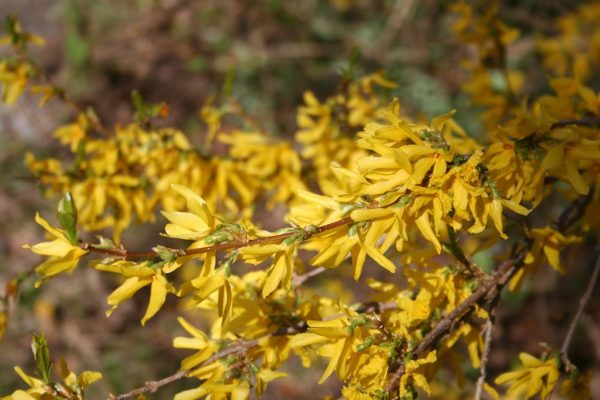
Spectabilis
Spectabilis is a 1 m high bush with large flowers and leaves that change color depending on the season: when it is warm they are green, and in autumn they acquire yellowish-purple hues. Requires shelter in winter in central Russia.
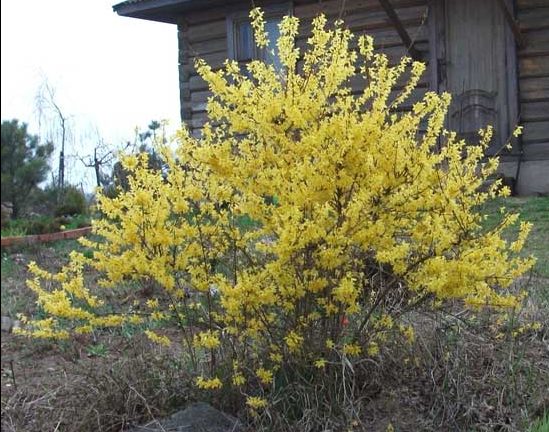
Tetragold
Tetragold is a frost-resistant variety of oval-leaved forsythia, height about 1 m, dark yellow flowers.
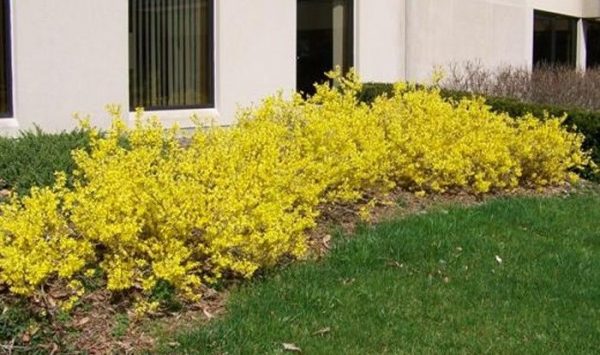
Bronxensis
Bronxensis is a low-growing variety of dark green forsythia.
Due to its early and long flowering, forsythia is widely used in landscape design. With the right choice of variety and proper care, the crop will delight gardeners in single and group plantings.
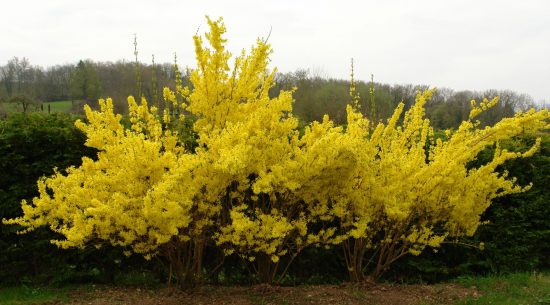
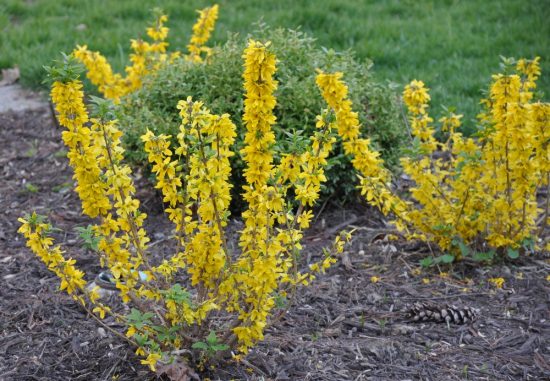
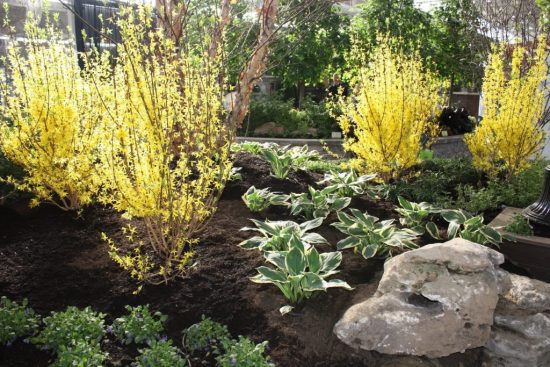
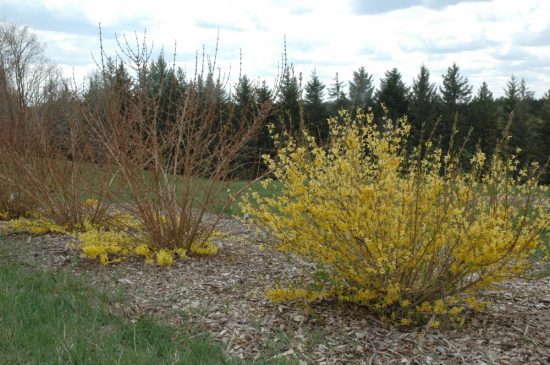
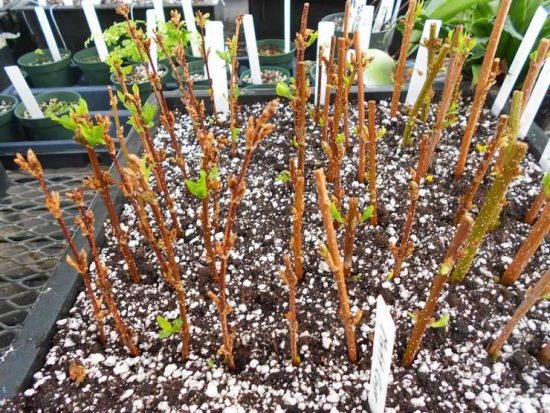
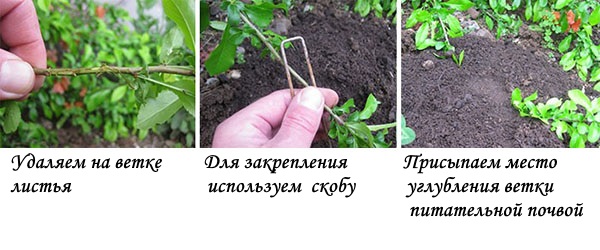

 CUCUMBERS NEVER GET SICK, I'VE BEEN USING ONLY THIS FOR 40 YEARS! I SHARE A SECRET WITH YOU, CUCUMBERS ARE LIKE THE PICTURE!
CUCUMBERS NEVER GET SICK, I'VE BEEN USING ONLY THIS FOR 40 YEARS! I SHARE A SECRET WITH YOU, CUCUMBERS ARE LIKE THE PICTURE! You can dig a bucket of potatoes from each bush. Do you think these are fairy tales? Watch the video
You can dig a bucket of potatoes from each bush. Do you think these are fairy tales? Watch the video
 How our fellow gardeners work in Korea. There is a lot to learn and just fun to watch.
How our fellow gardeners work in Korea. There is a lot to learn and just fun to watch. Eye trainer. The author claims that with daily viewing, vision is restored. They don't charge money for views.
Eye trainer. The author claims that with daily viewing, vision is restored. They don't charge money for views. A 3-ingredient cake recipe in 30 minutes is better than Napoleon. Simple and very tasty.
A 3-ingredient cake recipe in 30 minutes is better than Napoleon. Simple and very tasty. Therapeutic exercises for cervical osteochondrosis. A complete set of exercises.
Therapeutic exercises for cervical osteochondrosis. A complete set of exercises. Which indoor plants match your zodiac sign?
Which indoor plants match your zodiac sign? What about them? Excursion to German dachas.
What about them? Excursion to German dachas.